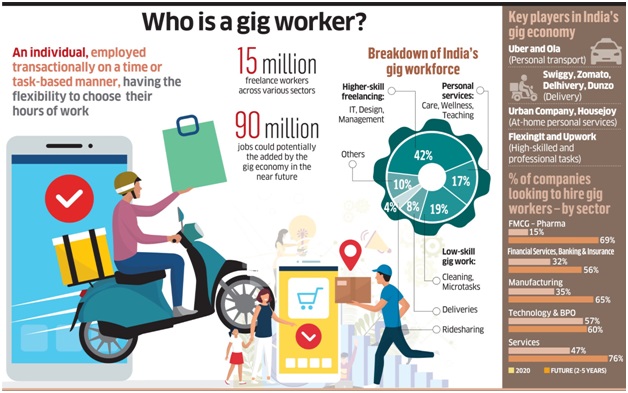Shaping India’s path to inclusive health care

- 08 Apr 2024
Why is it in the News?
World Health Day, which is observed every year on April 7, unites us around health equity, an essential topic at the heart of global health and justice.
Context:
- World Health Day, commemorated every April 7th, underscores the significance of health equity, acknowledged as a basic human entitlement by the World Health Organization (WHO).
- Hence, it is imperative to delve into the theme "My Health, My Right," delving into the hurdles and remedies in attaining health equity in India.
- As a country contending with multifaceted socioeconomic inequalities in healthcare access and results, this exploration becomes pivotal.
What is Health Equity?
- Health equity, as outlined by the WHO, embodies the principle that every person should have the opportunity to attain optimal health, irrespective of their social, economic, or environmental circumstances.
- It extends beyond mere healthcare access, addressing underlying factors such as poverty, discrimination, and resource imbalances.
- Considering Diverse Health Outcomes: A core tenet of health equity acknowledges that health results stem from a multifaceted interplay of elements, encompassing social, economic, and environmental determinants.
- Individuals from disadvantaged backgrounds often encounter obstacles like financial constraints, transportation limitations, and sparse healthcare facilities.
- The Vitality of Health Equity: Health equity holds paramount importance not only ethically but also from a public health standpoint.
- Research consistently indicates that societies fostering greater health equity typically enjoy superior health outcomes, marked by lower morbidity and mortality rates, reduced healthcare expenditures, and heightened life expectancy.
- Conversely, persistent health disparities may precipitate societal unrest, economic strains, and a squandered human potential.
Health Equity Challenges in India:
- Addressing Urban-Rural Disparities: India contends with pronounced healthcare inequalities between urban and rural regions, where urban areas typically boast superior healthcare infrastructure and services, while rural communities encounter obstacles like limited access to facilities, healthcare professionals, and infrastructure, resulting in inferior health outcomes compared to their urban counterparts.
- Navigating Overcrowded Urban Slums: Urban slums present profound challenges characterized by extreme poverty, overcrowding, unsanitary conditions, and inadequate access to clean water, fostering the spread of infectious diseases and escalating morbidity and mortality rates.
- Moreover, deficient healthcare infrastructure exacerbates health disparities as residents grapple with limited access to essential services.
- Tackling Socioeconomic and Caste Disparities: Marginalized groups, including Scheduled Castes, Scheduled Tribes, and economically disadvantaged populations, confront elevated rates of illness and death due to restricted healthcare access, diminished health literacy, and societal prejudice.
- These disparities intertwine with broader determinants like education, employment, and housing, perpetuating disparities in health outcomes.
- Confronting the Burden of Non-Communicable Diseases (NCDs): Non-communicable diseases (NCDs) such as cardiovascular ailments, diabetes, and cancer pose a mounting challenge to health equity in India, constituting a substantial portion of the disease burden.
- However, marginalized communities often face barriers to accessing preventive measures and NCD treatment, amplifying health inequalities and exacerbating existing socioeconomic gaps.
- Navigating Shortages in Healthcare Personnel: A severe shortage of healthcare professionals, with only 0.8 doctors per 1,000 individuals according to WHO data, exacerbates health challenges, particularly in rural areas where access to primary care is limited, resulting in delayed diagnoses, substandard treatment, and compromised health outcomes.
- Confronting Infrastructure and Resource Limitations: Inadequate healthcare infrastructure, insufficient funding, and resource limitations pose formidable obstacles to health equity in India, with many public facilities lacking essential equipment, medications, and skilled personnel.
- Furthermore, the unequal distribution of resources aggravates urban-rural healthcare disparities, exacerbating inequities in access to quality healthcare services.
Strategies and Measures to Advance Health Equity in India:
- Enhancing Primary Healthcare Services: A pivotal approach to fostering health equity in India involves bolstering primary healthcare provisions, especially in rural and marginalized regions.
- This entails augmenting the accessibility and availability of primary care facilities, fortifying the skills and capabilities of frontline healthcare personnel, and ensuring the delivery of essential health services encompassing preventive care, maternal and child healthcare, and management of chronic ailments.
- Initiatives such as the National Rural Health Mission (NRHM) and the National Urban Health Mission (NUHM) strive to extend primary healthcare access and mitigate healthcare disparities between urban and rural locales.
- Advocating for Universal Health Coverage: Universal health coverage (UHC) stands as a cornerstone in ensuring equitable access to indispensable healthcare services devoid of financial strains.
- Endeavors like Ayushman Bharat, India's flagship health insurance program, aspire to furnish financial safeguarding to vulnerable segments by offering comprehensive coverage for hospitalization expenses.
- By broadening the reach of quality healthcare services and alleviating out-of-pocket costs, UHC endeavors to redress discrepancies in healthcare accessibility and enhance health outcomes for all citizens.
- Targeting Social Determinants of Health: Attaining health equity mandates a multifaceted approach that transcends healthcare interventions to address the underlying social determinants of health, encompassing poverty, education, housing, and employment.
- Initiatives geared towards poverty mitigation, augmenting educational and sanitation access, and fostering livelihood opportunities can wield a transformative impact on health outcomes and help ameliorate health disparities.
- Programs like the Mahatma Gandhi National Rural Employment Guarantee Act (MGNREGA) furnish rural households with employment prospects, thereby fostering enhanced socioeconomic circumstances and superior health outcomes.
- Empowering through Health Literacy: Elevating health literacy assumes paramount significance in empowering individuals to make informed health decisions and pursue equitable healthcare access.
- Integration of health education within prevailing healthcare schemes can heighten public consciousness and advocate for preventive healthcare practices.
- Fostering Collaborative Endeavors: Efficacious collaboration among governmental bodies, civil society, healthcare providers, and international entities constitutes a linchpin in addressing health inequities.
- By harnessing their respective competencies and resources, these stakeholders can conceptualize culturally sensitive health initiatives tailored to the distinctive requisites of diverse communities.
Conclusion
Realizing health equity in India necessitates coordinated endeavors spanning various sectors and involving diverse stakeholders. Through targeted interventions addressing socioeconomic health determinants, bolstering healthcare infrastructure, and fostering collaborative alliances, India can progress towards a future where equitable access to superior healthcare becomes a universal norm. The pursuit of health equity transcends moral imperatives, emerging as a pivotal prerequisite for fostering sustainable development and societal advancement.
Gig Economy and Gig Workers (Indian Express)

- 26 Jul 2023
Why in the News?
The Rajasthan government recently enacted the Rajasthan Platform Based Gig Workers (Registration and Welfare) Bill in the year 2023.
- Highlights of the Bill:
Rajasthan Platform-based Gig Workers Welfare Board will formulate welfare policies and address grievances of piece-rate gig workers.
- The board can determine the aggregator's cess percentage for the social welfare corpus, based on transaction volumes on the platform.
- Unique ID:
- All gig workers registered with any platform will automatically be registered with the board, receiving a unique ID valid for three years.
- Penalty:
- Violating data sharing and worker employment rules can result in fines up to 10 lakh for the first offense and up to 1 crore for subsequent ones.
- Suspension Authority:
- The board is authorized to recommend temporary or permanent suspension of errant aggregators in the state.
- Public Feedback:
- The draft Bill will soon be made available to the public for feedback, currently with the Law department.
- What is Gig Economy?
- The Gig economy offers flexible work arrangements, allowing individuals to take up short-term or part-time jobs based on their availability and preferences.
- It heavily relies on digital platforms and apps that connect gig workers with customers or clients seeking specific services.
- Many people engage in gig work to supplement their income or as a source of additional earnings, making it easier to diversify their income streams.
- The gig economy has faced controversies regarding worker rights, fair pay, and debates over whether gig workers should be classified as employees with access to employment benefits.
- Who are gig workers?
- As per the Code on Social Security, 2020, a gig worker is an individual who engages in work or work arrangements and earns from such activities independently, outside the scope of a conventional employer-employee relationship.
- Gig workers can be broadly classified into platform and non-platform-based workers.
- Platform Workers:
- These workers refer to individuals who perform tasks or services through online software apps or digital platforms like Zomato, Swiggy, Ola, and others.
- Non-platform Workers:
- These workers are typically casual wage and own-account workers in traditional sectors, working either part-time or full-time.
- Gig Economy in India:
- As per NITI Aayog's report titled 'India's Booming Gig and Platform Economy':
- Gig workers are individuals involved in income-earning activities beyond the conventional employer-employee arrangement and may also operate within the informal sector.
- According to a 2019 report by the India Staffing Federation, India is the fifth largest in flexi-staffing globally, after the US, China, Brazil and Japan.
- In 2020, approximately 7.7 million workers were actively engaged in the gig economy.
- The gig workforce is expected to grow significantly, reaching 23.5 million workers by the year 2029-30.
- Currently, around 47% of gig work falls under medium-skilled jobs, 22% in high-skilled, and 31% in low-skilled jobs.
- There is a noticeable trend showing a gradual decline in medium-skilled workers' concentration, while the number of low-skilled and high-skilled workers is on the rise.
- Challenges faced by Gig workers:
- Impact on Full-time Employment Growth: The gig economy trend can hinder the growth of full-time employment as some employers may prefer to hire contracted workers due to cost-effectiveness and flexibility.
- Disruption of Work-life Balance: For certain workers, the flexibility of gig work can lead to disruptions in work-life balance, affecting sleep patterns and daily activities.
- Potential Replacement of Full-time Employees: Freelance workers in the gig economy may replace the need for a higher number of full-time employees within a company.
- Lack of Job Security: In the gig economy, workers have a more entrepreneurial role, which means they may experience less job security with no guaranteed steady income, pay, or benefits.
- Absence of Regular Job Benefits: Employers often avoid providing benefits such as health coverage and paid vacation time to gig workers, as they are not part of a formal employment relationship with the platform company. This lack of benefits can make short-term contracts less appealing and challenging to include on resumes.
- Government Initiatives for Gig Workers India:
- Code of Social Security, 2020: The Government introduced the Code on Social Security, 2020, aiming to develop suitable social security schemes for gig workers and platform workers, covering aspects like life and disability insurance, accident coverage, health and maternity benefits, and old age protection.
- However, these provisions are yet to be implemented.
- e-Shram Portal: In 2021, the Government launched the e-Shram portal, designed for the registration and establishment of a Comprehensive National Database of Unorganized Workers, including gig workers and platform workers.
- This portal facilitates self-declaration registration for individuals engaged in approximately 400 different occupations.
- Way Forward
The Gig Economy holds promising opportunities for India's extensive workforce, particularly for low-skilled laborers. To harness its potential, the Government should take proactive measures to foster the growth of gig economy platforms. Simultaneously, safeguarding the welfare of gig workers is crucial, ensuring fair working conditions and access to social security benefits. Striking this balance will require collaborative efforts from all stakeholders involved.
- Mains Question:
Discuss the Government's role in supporting the Gig Economy while safeguarding gig workers' interests. How can a balance be achieved between promoting the gig economy and protecting the welfare of gig workers? (20 M)
